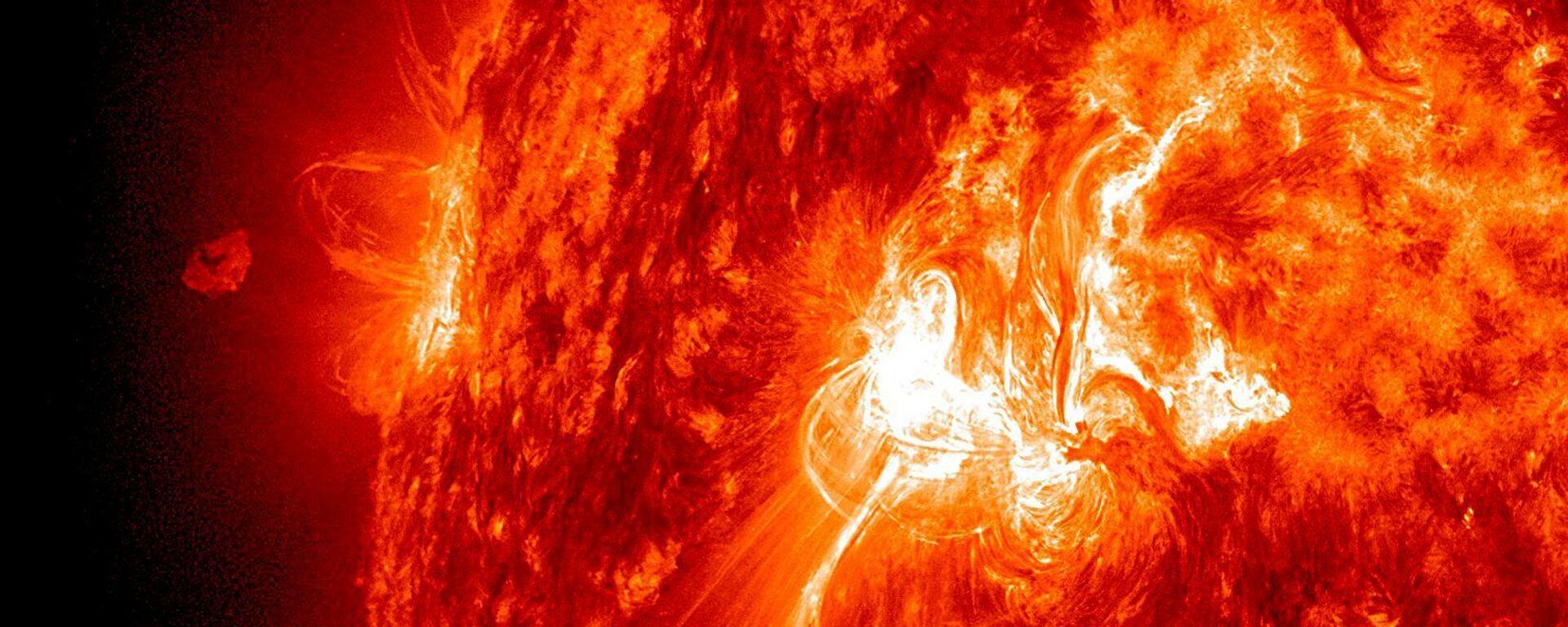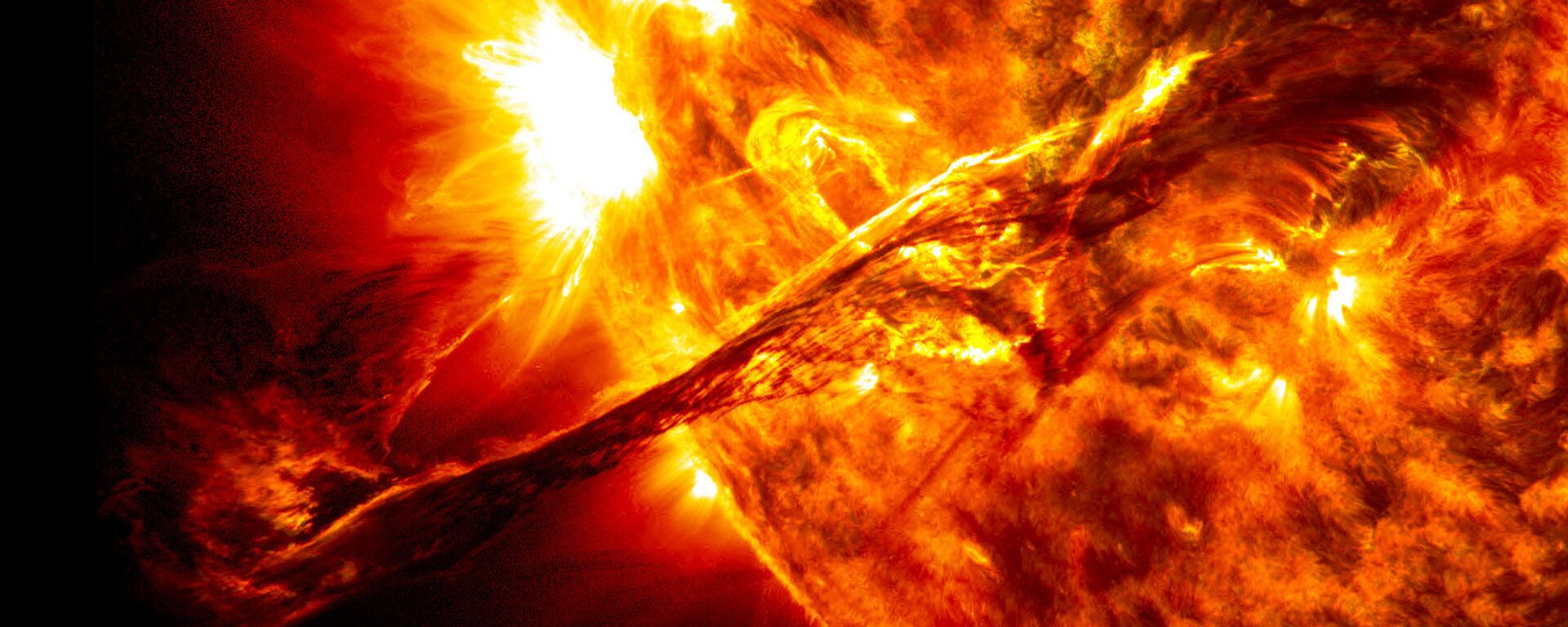https://sputnikglobe.com/20231105/impact-of-giant-crack-on-suns-surface-assessed-by-russian-scientist-1114741815.html
Impact of Giant ‘Crack’ on Sun’s Surface Assessed By Russian Scientist
Impact of Giant ‘Crack’ on Sun’s Surface Assessed By Russian Scientist
Sputnik International
Speculations that giant 'cracks' had formed on the surface of the Sun have been dismissed by Russian researcher, Professor Boris Filippov, Chief Researcher at the Institute of Terrestrial Magnetism of the RAS.
2023-11-05T14:24+0000
2023-11-05T14:24+0000
2023-11-05T14:24+0000
beyond politics
science & tech
sun
solar flare
https://cdn1.img.sputnikglobe.com/img/18119/16/181191689_0:152:1280:872_1920x0_80_0_0_7740fbf1c125752f4d4140eab955bb01.jpg
Speculations that giant cracks formed on the surface of the Sun have been dismissed by a Russian researcher.What laymen dub “cracks” are in fact luminous clouds, explained Professor Boris Filippov, Doctor of Physical and Mathematical Sciences, Chief Researcher at the Institute of Terrestrial Magnetism at the Russian Academy of Sciences.A number of reports appeared earlier in November, suggesting that a huge fissure, or a "canyon of fire" had been formed on the solar surface, approximately 6,200 miles (10,000km) wide, and more than seven times as long as our planet Earth.“First, there are no cracks in the Sun… this will not cause the orb to fall apart,” the researcher told Russian media.Filippov explained that when observed at the edge of the star located at the heart of our solar system, these luminous clouds are called "prominences".When they collide with the Earth's magnetic field, coronal mass ejections cause strong magnetic storms.Filippov warned that our planet could soon be in for a magnetic storm caused by the latest solar flare. Though he allayed any fears of ensuing earthquakes or floods on Earth, Filippov underscored that geomagnetic disturbances caused by geomagnetic storms have been known to affect the power grid, trigger radio blackouts around the world, and mobile-phone outages, as well as affect satellites, and even some people’s health.Incidentally, earlier it was reported that increased occurrence of "cannibal" coronal mass ejections (CMEs) suggested the solar maximum, the peak of the sun's approximately 11-year solar cycle, was approaching, set to bring with it intensified solar activity, resulting in more sunspots and solar flares.
https://sputnikglobe.com/20230506/coronal-holes--flares-which-solar-eruptions-will-impact-earth-as-sun-intensifies-1110132872.html
https://sputnikglobe.com/20231010/tree-ring-analysis-tells-tale-of-largest-ever-solar-storm-14000-years-ago-1114078138.html
https://sputnikglobe.com/20230717/cannibal-coronal-mass-ejection-to-hit-earth-tuesday-cause-geomagnetic-storm-1111951993.html
Sputnik International
feedback@sputniknews.com
+74956456601
MIA „Rossiya Segodnya“
2023
News
en_EN
Sputnik International
feedback@sputniknews.com
+74956456601
MIA „Rossiya Segodnya“
Sputnik International
feedback@sputniknews.com
+74956456601
MIA „Rossiya Segodnya“
solar flares, solar filament, coronal mass ejections, cme, strong magnetic storms, geomagnetic storms
solar flares, solar filament, coronal mass ejections, cme, strong magnetic storms, geomagnetic storms
Impact of Giant ‘Crack’ on Sun’s Surface Assessed By Russian Scientist
An unstable solar plume was registered on the Sun's southern hemisphere on 31 October. After the prominence erupted, launching out into space, it left behind what reports dubbed a fiery "canyon" on the solar surface.
Speculations that giant cracks formed on the
surface of the Sun have been dismissed by a Russian researcher.
What laymen dub “cracks” are in fact luminous clouds, explained Professor Boris Filippov, Doctor of Physical and Mathematical Sciences, Chief Researcher at the Institute of Terrestrial Magnetism at the Russian Academy of Sciences.
A number of reports appeared earlier in November, suggesting that a huge fissure, or a "canyon of fire" had been formed on the solar surface, approximately 6,200 miles (10,000km) wide, and more than seven times as long as our
planet Earth.
“First, there are no cracks in the Sun… this will not cause the orb to fall apart,” the researcher told Russian media.
“What journalists usually like to call ‘cracks’ - and it should be noted that in images of the Sun in some spectrums, dark lines are, in fact, visible - are most often protuberances that are visible against the background of the solar disk,” the scientist said.
Filippov explained that when observed at the edge of the star located at the heart of our solar system, these luminous clouds are called "prominences".
“If the phenomenon is not bright, but dark, and is observed on the surface of the sun, then it is called a solar filament. These filaments are clumps of plasma, that sometimes lose solar equilibrium, rising quickly outward, explode, and turn into an ejection, moving through interplanetary space,” the scientist said.
Solar prominences and filaments appear as dark filamentary objects on the solar disk (filaments) and as protuberances on the edge of the solar disk (prominences).
When they collide with the Earth's
magnetic field, coronal mass ejections cause strong magnetic storms.

10 October 2023, 21:15 GMT
Filippov warned that our planet could soon be in for a magnetic storm caused by the latest solar flare. Though he allayed any fears of ensuing earthquakes or floods on Earth, Filippov underscored that geomagnetic disturbances caused by
geomagnetic storms have been known to affect the power grid, trigger radio blackouts around the world, and mobile-phone outages, as well as affect satellites, and even some people’s health.
Incidentally, earlier it was reported that increased occurrence of
"cannibal" coronal mass ejections (CMEs) suggested the solar maximum, the peak of the sun's approximately 11-year solar cycle, was approaching, set to bring with it intensified solar activity, resulting in more sunspots and solar flares.





